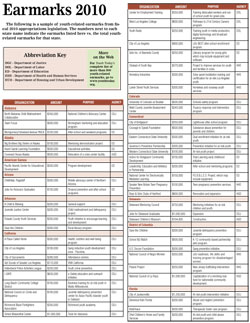|
Click image for a four-page earmark |
The number of youth earmarks continues its descent in the fiscal 2010 federal budget, signed by President Obama in December, and many of those were included in appropriations bills that are aimed at getting youth out of gangs and into the workplace.
As always, counting the number of congressionally earmarked projects that will go directly toward serving youth is an inexact science. Youth Today found 813 earmarks by poring over various congressional appropriations. That number is down from just over 1,000 in fiscal 2009 and compared with 1,363 in fiscal 2005, the last year of the go-go era of youth earmarks.
But the bigger difference is in dollars. The youth earmarks totaled $309 million in fiscal 2010, compared with $636 million for 2009. So there were more than three-quarters as many earmarks as in fiscal 2009, but the cost was less than half.
A large part of the money decline can be explained by the $168 million in earmarks last year that went to 11 military bases to build child development centers.
But the pork going to organizations from a couple of traditional youth-serving agencies is decidedly down. There are 55 fewer youth earmarks in the appropriation for the Department of Health and Human Services and 93 fewer for the Department of Education. Only the Department of Justice is pretty much even with last year’s pork rationing: 449 youth earmarks this year, 462 in 2009.
As always, California and New York account for a huge chunk of the bacon slab. The Golden State and the Empire State combine for 208 earmarks, a quarter of the total.
A few trends that Youth Today noticed for 2010:
Jobs and gangs: Gang prevention has always been a huge part of the Justice Department earmarks, but it seems that projects to provide job training and work with gang-involved youth are this year’s dominant theme. About 90 earmarks, more than 10 percent of all youth earmarks on the Youth Today list, went either to projects that specifically mentioned working with gang-affiliated youth or for job training.
The biggest winner appears to be Jobs for America’s Graduates, whose affiliates in five states (Arizona, Delaware, Maine, Mississippi and Ohio) snagged a total of seven earmarks totaling $2.15 million. Jobs for Delaware’s Graduates took in $1 million of that.
Another priority for appropriators appears to be fitness. About 35 earmarks went toward projects devoted to health, fitness or confronting childhood obesity.
Abstinence out: The word abstinence does not appear once in the 2010 list of earmarks, which is shocking, when one considers that there were about 130 earmarks related to abstinence in the six years of appropriations documents before 2010.
Porking abstinence was hardly a national trend, though, as nearly all of the earmarks were secured by Sen. Arlen Specter for Pennsylvania. It is probably not a coincidence that Specter’s abstinence earmarking stopped the same year he defected from the Republican party to become a Democrat.
Forsaken Alaska: Do you think the former youth earmark recipients in Alaska miss former Sen. Ted Stevens (R), who left the Senate in January 2009? Check out youth projects steered into the state since 2003 (not counting 2006 and 2007, two years in which earmarks for youth-serving agencies were mostly axed):
2003: 31
2004: 36
2005: 33
2008: 15
2009: 15
2010: 5
This is one of the conundrums with earmarks: for better or worse, the fate of grantees is tied to a guy in office instead of an actual track record. Stevens steered pork toward some bad programs (like the now-defunct LOVE Social Services), but also some good ones.
In 2010, 4-H cooperative educational service agencies in Wisconsin are flush with federal money because Rep. David Obey (D-Wisc.) essentially runs the appropriations show. Four of the co-ops received a total of $1.4 million in earmarks. What happens when Obey retires, loses an election, or steps away from the appropriations committee?
Residential bailout: State budget cutbacks, along with momentum toward community-based services in some areas, have left some residential care providers in a precarious state. A number sought, with success, relief at the pork trough. Among the residential programs that got a fiscal boost from appropriators:
• Covenant House: nine earmarks totaling $2.55 million for operations in Florida, New York, New Jersey, Georgia, California and Alaska.
• Starr Commonwealth: six earmarks, totaling $2.4 million, for services in Michigan and Ohio.
• Devereux: three earmarks, totaling $400,000, for programs in Pennsylvania and Florida.
Another stalwart of residential services and earmarks – Orefield, Pa.-based KidsPeace – used earmarks to help finance expansion of its non-residential services. KidsPeace got four earmarks, totaling $1 million, for therapeutic foster care in Florida, New Jersey, Indiana and New York. It also received $150,000 for day treatment in Maine.
Doubling Up: A lot of pork-seekers (more than usual) had success this year landing earmarks from different accounts for essentially the same project. For example, New York-based Ocean Bay Community Development Corp. landed $100,000 from the Department of Labor to do a “workforce preparation program with youth in public housing.”
The same organization got $100,000 from HHS. The purpose of that earmark: “workforce development program with youth and young adults residing in public housing.”
Chabad: It seems as if every year, a new organization enters the earmark fraternity with a loud thud. This year it was most certainly West Coast Chabad Lubavitch, a Jewish service organization that gave Washington, D.C., lobbying giant Patton Boggs $120,000 to secure 2010 earmarks, according to lobbyist disclosure records filed with the U.S. Senate.
The investment paid off. Chabad Lubavitch pulled in $1.3 million in five youth earmarks (four from Justice, one from HHS), and snagged another $250,000 from the Department of Housing and Urban Development to renovate an emergency shelter and social services center. Most of the money will go toward drug education and prevention programs.


























